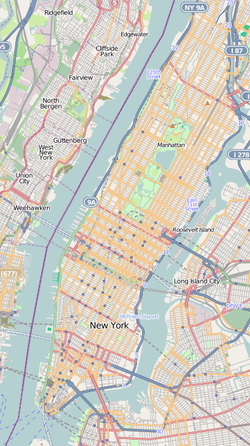Pier 40 at Hudson River Park
| Pier 40, The Pier | |

Pier 40 (front) and piers 45 and 46, as seen from One World Observatory
|
|
| Address | 353 West Street, New York, NY 10014 |
|---|---|
| Location | Greenwich Village |
| Coordinates | 40°43′45″N 74°0′45″W / 40.72917°N 74.01250°WCoordinates: 40°43′45″N 74°0′45″W / 40.72917°N 74.01250°W |
| Owner |
State of New York City of New York |
| Operator | Hudson River Park Trust |
| Type | Multi-purpose |
| Seating type | Movable bleachers |
| Field size | 400 × 400 feet |
| Field shape | Square |
| Acreage | 15 |
| Surface | Turf |
| Construction | |
| Broke ground | July 31, 1958 |
| Opened | October 24, 1962 (as ship terminal) May 12, 2005 (as Hudson River Park) |
| Renovated | 1998–2005 |
| Construction cost | $19 million |
| Tenants | |
| New York Knights | |
Pier 40 at Hudson River Park, more commonly known as Pier 40, is a parking garage, sports facility, and former marine terminal located at the west end of Houston Street in Manhattan, New York City, within Hudson River Park. It is home to the New York Knights of the American National Rugby League (ANRL), though it is primarily used by youth and high school athletics.
The pier is the largest structure in Hudson River Park at over 14 acres in size, and is the home to the Hudson River Park Trust's offices. Various park tenants host activities as well. Sports include baseball, football, soccer, kayaking, rowing, trapeze arts, and rugby among others.
Prior to the construction of Pier 40, five city-owned "finger" piers were located at the site. These were from south-to-north Pier 37 (at Charlton Street), Pier 38 (at King Street), Pier 39 (at West Houston Street), Pier 40 (at Clarkson Street), and Pier 41 (at Leroy Street). Companies using the piers in the early 20th Century included the Southern Pacific Transportation Company, the Delaware, Lackawanna and Western Railroad (DL&W), and the Atlantic Transport Line. By the 1950s, the piers were used by the DL&W and the Baltimore and Ohio Railroad.
The current Pier 40 was proposed as a passenger and cargo terminal in February 1956 by the city's Marine and Aviation department. The plan was put forward to allow the Holland America Line to move its area operations from Hoboken, New Jersey on the other side of the Hudson River, where the company was based for 73 years. It was the first terminal of its kind to be built by the city, and was designed as a "massive hollow square" with three levels to accommodate cars, taxis, and commercial trucks. The massive four block structure replaced the five smaller "finger" piers. Construction began in 1958 at the cost of over $18 million, and the Pier began operations in 1962, with Holland America signing a 20-year lease for over $1.2 million in annual rent. Holland America also moved its offices from the Financial District to Pier 40. In its first year in operation, Pier 40 served over 2,000 passengers daily. In 1971, the Pier was taken over by the Port Authority of New York and New Jersey. Holland America moved their operations to the New York Passenger Ship Terminal in Hell's Kitchen in 1974. Pier 40 ceased serving ships at that time, and ended all operations around 1983.
...
Wikipedia




